Your baby will go through 2,500 to 3,000 diapers in their first year alone, which means you need to set aside a sizable chunk of change for your newborn to do their business. A wide range of factors, from how sensitive your baby’s skin is to how much you’re trying to limit your carbon footprint, influence exactly how much you will spend.
While those are all important things to consider, your first priority will be finding a diaper that works for your baby — one that doesn’t leak, fits well and generally does what a diaper is supposed to do. After testing diapers for nearly a month, I’ve found that just about every affordably priced diaper available in stores or at major online retailers like Amazon will do the trick. The best diaper in this category, which diaper industry experts call the economy segment, really comes down to personal preference.
Read more: Does the child tax credit apply to 2021 babies? Yes, and here’s how to claim it
“When you are comparing diapers and the absorbent core is about the same, then you are looking only at the outside features like patterns and fashion,” says Carlos Richer, CEO of Diaper Testing International. Diaper softness is another feature that tends to woo parents, but softness has little effect on the comfort of the baby. It’s the quality of a diaper’s absorbent core that has the most bearing on comfort, and you don’t see major differences in absorbency until you get to the higher end of the price spectrum (50 cents per diaper and above), according to Richer.
We hope to test some super premium diapers soon to see if there really is an appreciable difference in how they perform. But for now, here’s a look at the more affordable diapers on the market. All prices listed are for a full box of diapers, at the minimum size and price.
And, if you’re a new parent looking to make your life a little easier, we have recommendations for baby food delivery services, apps, breast pumps and even a how-to guide for helping your baby fall asleep fast.
Read more: Best baby thermometer for 2022

 \n ","topic":"","ttag":"","variant":"","viewguid":"","event":"listicle|image|1","correlationId":"","_destCat":"https:\/\/www.amazon.com\/dp\/B08QRYHC38?ref=emc_p_m_5_i","productName":"Huggies","formatType":"IMAGE","location":"LIST","position":1,"sku":"","dwLinkTag":"article-body|listicle|image","selector":"#article-body #listicle-7b2db2a9-dfbb-4a89-8c43-6ff5caf1ef94 .itemImage"}}” rel=”noopener nofollow” target=”_blank”>
\n ","topic":"","ttag":"","variant":"","viewguid":"","event":"listicle|image|1","correlationId":"","_destCat":"https:\/\/www.amazon.com\/dp\/B08QRYHC38?ref=emc_p_m_5_i","productName":"Huggies","formatType":"IMAGE","location":"LIST","position":1,"sku":"","dwLinkTag":"article-body|listicle|image","selector":"#article-body #listicle-7b2db2a9-dfbb-4a89-8c43-6ff5caf1ef94 .itemImage"}}” rel=”noopener nofollow” target=”_blank”>
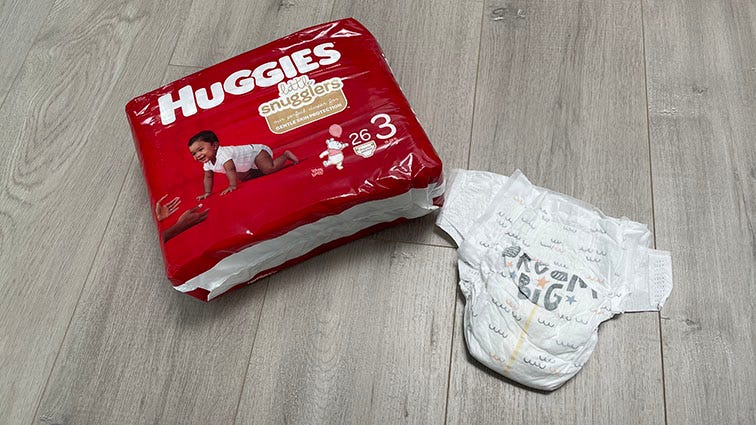

Alex Nishimoto/CNET
Huggies is the diaper brand my family has used for the past three years, going back to the birth of my son. They’re soft, reliable and won’t break the bank. Having tried other brands, we settled on Huggies pretty early in our parenting journey. With that said, it’s impossible to review them without bias.
All parents go through pretty much the same trial-and-error process to find a diaper they like. In the beginning, you’ll go through pack after pack of different diapers (hopefully gifted to you at your baby shower) until you find one that works best for your baby. This test was a lot like those first few weeks with my newborn son, except this time we had a chance to better evaluate and analyze how each diaper performed, since my 11-month-old daughter is past the poop-every-five-minutes-and-oh-my-god-it’s-everywhere stage.
Once again, the Huggies stood out as a solid contender. They fit her well, never leaked or blew out and performed OK overnight. Her skin was always wet in the morning and occasionally red from prolonged exposure to urine. I don’t know where companies get their 12-hour protection claims, but in my experience none of them deliver on promises of dryness over such long periods of time.
Huggies has two main lines of regular diapers: Little Snugglers (which go up to size 4) and Little Movers. For this test, we sampled Little Snugglers. The waistband stretches and fastens securely, and the leg holes are just right around my little girl’s substantial thigh meats. The fit is nice, but the look is slightly baggy, in case that bothers you. Overall, after sampling much of the competition, I still like Huggies. Just know that being a name brand, they’re not the cheapest on the market (ranging from 24 cents all the way up to 61 cents each for size 6).

 \n ","topic":"","ttag":"","variant":"","viewguid":"","event":"listicle|image|2","correlationId":"","_destCat":"https:\/\/www.amazon.com\/Amazon-Brand-Gentle-Touch-Diapers\/dp\/B07T4WQRN1\/?th=1","productName":"Mama Bear Gentle Touch","formatType":"IMAGE","location":"LIST","position":2,"sku":"","dwLinkTag":"article-body|listicle|image","selector":"#article-body #listicle-a2f2f373-d884-4e79-95e4-46b5ffb8928f .itemImage"}}” rel=”noopener nofollow” target=”_blank”>
\n ","topic":"","ttag":"","variant":"","viewguid":"","event":"listicle|image|2","correlationId":"","_destCat":"https:\/\/www.amazon.com\/Amazon-Brand-Gentle-Touch-Diapers\/dp\/B07T4WQRN1\/?th=1","productName":"Mama Bear Gentle Touch","formatType":"IMAGE","location":"LIST","position":2,"sku":"","dwLinkTag":"article-body|listicle|image","selector":"#article-body #listicle-a2f2f373-d884-4e79-95e4-46b5ffb8928f .itemImage"}}” rel=”noopener nofollow” target=”_blank”>
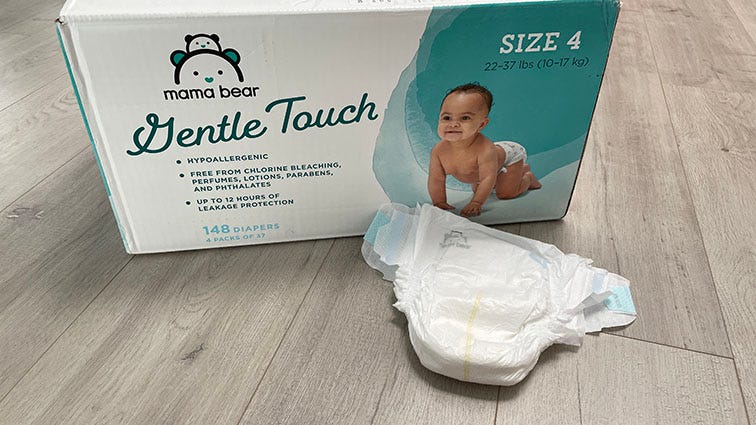

Alex Nishimoto/CNET
Mama Bear is Amazon’s own brand of diaper, and in line with the e-commerce giant’s MO, the online-only private label offers a decently competitive product at a relatively low price — plus the convenience of Prime shipping.
The diapers themselves aren’t much to look at. The two styles in my pack were plain white and polka-dot print. But there are a few features that earn the Mama Bear some style points. On the diaper’s front flaps there’s a strip of high-friction material that helps it stay put when you wrap the rear flap around to fasten it. The Velcro tabs stick to the diaper very securely, so much so that it takes some effort to remove them.
Beyond that, though, the Mama Bear is about as basic as a diaper can be. Like many other brands, the Mama Bear has a wetness indicator strip running down the middle, though it didn’t always change color even when the diaper was clearly wet enough to change. The outer layer is said to be breathable despite feeling somewhat plasticky. They fit my daughter fairly well in size 4, giving her only a slight puffy-butt look. The leg holes seemed tight enough around the thighs, but she did have a minor blow-out once.
Absorption seemed on par with the other economy diapers I tested, though her skin was often damp after a change. It must be said that Mama Bear makes no claims about the sustainability or eco-friendliness of its products, which probably means it doesn’t have anything to offer on the green front. But if you’re not too concerned with that and don’t mind the lack of cute prints, the Mama Bear is a good value at 21 cents a pop for size 4.

 \n ","topic":"","ttag":"","variant":"","viewguid":"","event":"listicle|image|3","correlationId":"","_destCat":"https:\/\/www.amazon.com\/Honest-Company-TrueAbsorb-Technology-Strawberries\/dp\/B07G4TLZYQ\/?th=1","productName":"Honest Diapers","formatType":"IMAGE","location":"LIST","position":3,"sku":"","dwLinkTag":"article-body|listicle|image","selector":"#article-body #listicle-ed402f26-9ef2-4cd5-b3ab-4213b75557a5 .itemImage"}}” rel=”noopener nofollow” target=”_blank”>
\n ","topic":"","ttag":"","variant":"","viewguid":"","event":"listicle|image|3","correlationId":"","_destCat":"https:\/\/www.amazon.com\/Honest-Company-TrueAbsorb-Technology-Strawberries\/dp\/B07G4TLZYQ\/?th=1","productName":"Honest Diapers","formatType":"IMAGE","location":"LIST","position":3,"sku":"","dwLinkTag":"article-body|listicle|image","selector":"#article-body #listicle-ed402f26-9ef2-4cd5-b3ab-4213b75557a5 .itemImage"}}” rel=”noopener nofollow” target=”_blank”>
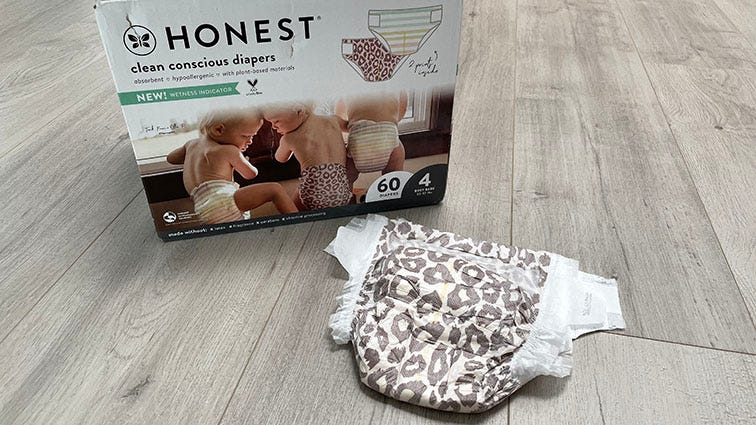

Alex Nishimoto/CNET
With Honest Diapers’ substantial price premium over other major brands, you’d expect a noticeable bump in quality and performance to justify paying the extra cash. But instead you get a diaper that’s just OK. At first glance, the inside of the diaper looked like it would handle liquid better than other diapers I tested, with channels running almost the full length of the diaper. In reality, though, these diapers still leaked on two occasions and my daughter’s skin was always noticeably wet after an overnight change.
What you pay for, it seems, is the look. Honest diapers are available in a variety of prints, with some being limited edition or only available seasonally. This made them by far the most visually interesting to look at of all the diapers I tested. But how much will that matter when you roll it up (oftentimes filled with poop) and throw it in the garbage? These diapers were also the most form-fitting of the bunch. The contoured rear clung to my daughter’s tush with little sag or puffiness. But that shapeliness might come at a price. My daughter had a three-way blowout (up the back and out both leg holes) in an Honest diaper — by far the messiest incident of the test — and I suspect it may have something to do with the poop having nowhere to go.
The Honest Company likes to flex its green credentials in its marketing, but some of the eco-friendly features it touts are dubious. One example is the “plant-based” polylactic acid outer layer, which may come from plants but is still a plastic that won’t degrade for hundreds of years. At 47 cents per diaper in size 4, Honest is overpriced and not much better (if at all) than any other diaper on this list.

 \n ","topic":"","ttag":"","variant":"","viewguid":"","event":"listicle|image|4","correlationId":"","_destCat":"https:\/\/www.amazon.com\/Diapers-Size-234-Count-Disposable\/dp\/B00DEYYRGM\/?th=1","productName":"Pampers","formatType":"IMAGE","location":"LIST","position":4,"sku":"","dwLinkTag":"article-body|listicle|image","selector":"#article-body #listicle-c7cb4fed-cf59-41aa-9d84-95b60c75434a .itemImage"}}” rel=”noopener nofollow” target=”_blank”>
\n ","topic":"","ttag":"","variant":"","viewguid":"","event":"listicle|image|4","correlationId":"","_destCat":"https:\/\/www.amazon.com\/Diapers-Size-234-Count-Disposable\/dp\/B00DEYYRGM\/?th=1","productName":"Pampers","formatType":"IMAGE","location":"LIST","position":4,"sku":"","dwLinkTag":"article-body|listicle|image","selector":"#article-body #listicle-c7cb4fed-cf59-41aa-9d84-95b60c75434a .itemImage"}}” rel=”noopener nofollow” target=”_blank”>
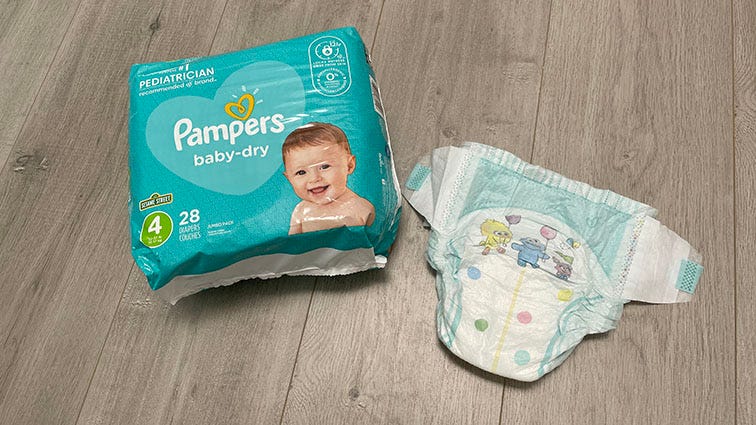

Alex Nishimoto/CNET
Founded in 1961, Pampers has been a major player in the disposable diaper game for 60 years. There’s a good chance your parents, and perhaps even their parents, wore Pampers. Being a household name for that long gives the brand a huge advantage in the market, and for the most part Pampers’ reputation is earned by offering reasonable quality at an affordable price.
The Pampers performed well in tests. The elastic band creates a tight seal at the waist while still having plenty of give for comfort. The Velcro tabs separate from the back flaps easily and are teal-colored, a feature my vision-impaired father-in-law appreciated as it made them easier to see compared to white on white. The leg holes fit my daughter’s thighs somewhat loosely, but I experienced no leakages. The diaper held overnight, though it left her skin damp in the morning despite these testers belonging to the Pampers Baby Dry line.
Pampers work perfectly fine for the money (32 cents each in size 4), but I just can’t get past their baby powder-like smell. The fragrance is “non-allergenic and non-irritating to the skin,” according to Pampers, but it’s a bit too strong for me. The Pampers Pure line is fragrance-free, though more expensive at 33-60 cents per diaper. On the topic of ingredients, Pampers says it uses elemental chlorine-free fluff pulp that comes from Sustainable Forestry Initiative-certified sources.

 \n ","topic":"","ttag":"","variant":"","viewguid":"","event":"listicle|image|5","correlationId":"","_destCat":"https:\/\/www.amazon.com\/Luvs-Leakguards-Disposable-Diapers-SUPPLY\/dp\/B01EKZO93O\/?th=1","productName":"Luvs","formatType":"IMAGE","location":"LIST","position":5,"sku":"","dwLinkTag":"article-body|listicle|image","selector":"#article-body #listicle-f12dbb3a-64d5-4aae-a521-b23891a715f4 .itemImage"}}” rel=”noopener nofollow” target=”_blank”>
\n ","topic":"","ttag":"","variant":"","viewguid":"","event":"listicle|image|5","correlationId":"","_destCat":"https:\/\/www.amazon.com\/Luvs-Leakguards-Disposable-Diapers-SUPPLY\/dp\/B01EKZO93O\/?th=1","productName":"Luvs","formatType":"IMAGE","location":"LIST","position":5,"sku":"","dwLinkTag":"article-body|listicle|image","selector":"#article-body #listicle-f12dbb3a-64d5-4aae-a521-b23891a715f4 .itemImage"}}” rel=”noopener nofollow” target=”_blank”>
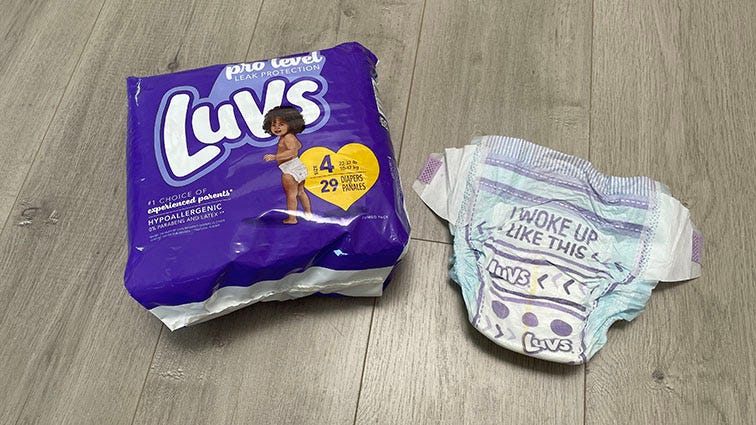

Alex Nishimoto/CNET
These diapers have a lot in common with Pampers — and that’s no coincidence. Both Luvs and Pampers are owned by Procter & Gamble, with the former serving as the budget brand. But looking at a Luvs and a Pampers Baby Dry side by side, it’s hard to tell where they cut costs.
The waistband is practically identical to the Pampers, having the same stretchy back flaps with easy-to-peel-apart fastener tabs. As you might expect, this means the fit is about the same, which is to say very good. Even peeking under the top sheet with an X-Acto knife revealed no clear differences to my untrained eyes. Both appeared to have the same amount of fluff pulp and three rows of super absorbent polymer gel. I have not sampled Pampers’ Swaddlers or Cruisers lines, so I can’t say if those are also similar.
One difference that puts Luvs a rung up from Pampers in my book: Luvs have no fragrance! I also appreciate the brand’s more simplified lineup — there’s one Luvs diaper and that’s it. However, I can see how this could be a downside if Luvs don’t fit your baby well. But if they do, you’ll save a considerable amount compared to Pampers as each diaper costs just 13-26 cents.

 \n ","topic":"","ttag":"","variant":"","viewguid":"","event":"listicle|image|6","correlationId":"","_destCat":"https:\/\/www.costco.com\/kirkland-signature-diapers-sizes-3-6.product.100766695.html","productName":"Kirkland Signature (Costco)","formatType":"IMAGE","location":"LIST","position":6,"sku":"","dwLinkTag":"article-body|listicle|image","selector":"#article-body #listicle-396d393c-8e46-4690-bb26-b77dffc85f71 .itemImage"}}” rel=”noopener nofollow” target=”_blank”>
\n ","topic":"","ttag":"","variant":"","viewguid":"","event":"listicle|image|6","correlationId":"","_destCat":"https:\/\/www.costco.com\/kirkland-signature-diapers-sizes-3-6.product.100766695.html","productName":"Kirkland Signature (Costco)","formatType":"IMAGE","location":"LIST","position":6,"sku":"","dwLinkTag":"article-body|listicle|image","selector":"#article-body #listicle-396d393c-8e46-4690-bb26-b77dffc85f71 .itemImage"}}” rel=”noopener nofollow” target=”_blank”>
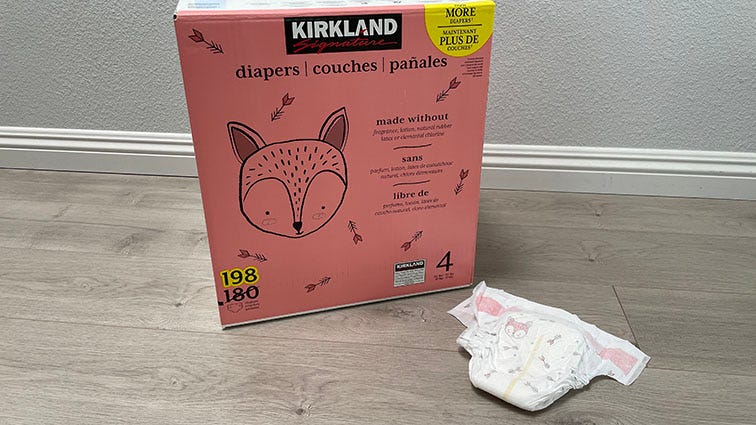

Alex Nishimoto/CNET
Because Costco heavily discounts the products it sells under its Kirkland Signature brand, the identities of Kirkland manufacturers are often kept secret to protect them from diluting their other, more expensive brands. It’s said that Kirkland Signature diapers are made by Kimberly-Clark, the personal care giant behind Huggies diapers.
Looking at the two side by side, it’s easy to spot some similarities. Both have stretchy elastic waistbands and long fastener tabs replete with Velcro hooks. The Kirkland also has a poo-catching pocket, a Huggies signature feature. On my baby, they fit about the same as the Huggies I’m used to. However, I noticed the Kirklands tend to be wetter after a night’s use, giving off a strong smell of urine through my daughter’s pajamas and sometimes being damp on the outside of the diaper. They didn’t leak necessarily, but they didn’t hold as well as others in the test.
It could be that the cost savings come from a less robust absorbent core, though we can only speculate. But with the savings you’ll see switching to Kirkland, you might be willing to put up with that. Kirkland Signature diapers range from 17-33 cents per diaper, depending on size. But like most things at Costco, you have to buy in bulk to get that price (as well as being a member). A box of size 4s contained 198 diapers and was big enough for my 3-year-old to play hide and seek in.
Costco doesn’t make many claims as to the sustainability of its diapers, but does say at least 20% of materials used in them are plant-based.

 \n ","topic":"","ttag":"","variant":"","viewguid":"","event":"listicle|image|7","correlationId":"","_destCat":"https:\/\/www.target.com\/p\/diapers-up-up-select-size-and-count\/-\/A-79808016","productName":"Up & Up (Target)","formatType":"IMAGE","location":"LIST","position":7,"sku":"","dwLinkTag":"article-body|listicle|image","selector":"#article-body #listicle-341a08c3-284b-4e19-b0e6-e427b7c86abe .itemImage"}}” rel=”noopener nofollow” target=”_blank”>
\n ","topic":"","ttag":"","variant":"","viewguid":"","event":"listicle|image|7","correlationId":"","_destCat":"https:\/\/www.target.com\/p\/diapers-up-up-select-size-and-count\/-\/A-79808016","productName":"Up & Up (Target)","formatType":"IMAGE","location":"LIST","position":7,"sku":"","dwLinkTag":"article-body|listicle|image","selector":"#article-body #listicle-341a08c3-284b-4e19-b0e6-e427b7c86abe .itemImage"}}” rel=”noopener nofollow” target=”_blank”>
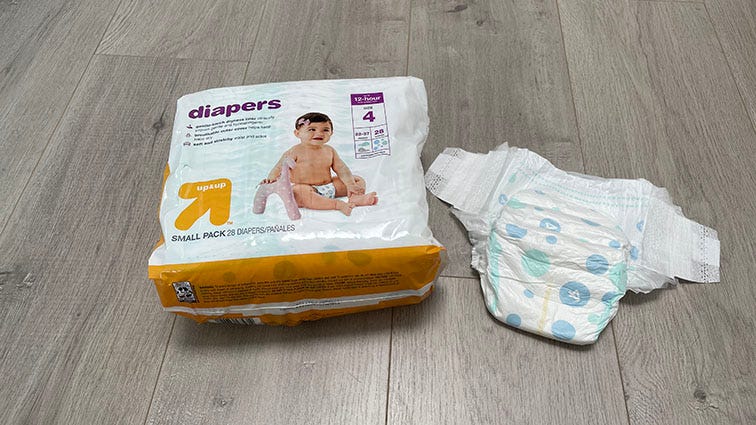

Alex Nishimoto/CNET
Choosing a store brand over a name brand can feel like a gamble. Will you get essentially the same thing for less money or will you get exactly what you pay for? At 10-25 cents per diaper, Target’s Up & Up brand delivers a product that works OK. They performed their intended function well enough in this test, but would they be worth it in the long run? That’s tough for me to say.
There’s no mistaking this diaper for anything other than a budget option. Just handling them back to back with the other diapers I tested, they feel insubstantial. The pattern, while colorful, looks plain and generic (mine had whales printed on them) and the outer layer feels plasticky and cheap. But once I got past that, I found the Up & Ups fit my baby well thanks to an elastic waistband with accordion-like flaps that are easy to pull tight while still allowing her room to move. I experienced no leaks with these diapers, though they did smell strongly of urine after an overnight change. My daughter’s skin was wet in the morning, but none of the diapers I tested were able to keep her completely dry overnight.
They fit her well, but they’re a little on the puffy side. Perhaps as a result, the Up & Ups offered some of the best coverage of this test, keeping her butt cheeks tucked inside most of the time. They work, and if you’re looking for savings above all else, they’ll serve you well. However, it should be noted that the ingredients list is light on green credentials.

 \n ","topic":"","ttag":"","variant":"","viewguid":"","event":"listicle|image|8","correlationId":"","_destCat":"https:\/\/www.amazon.com\/dp\/B0839917JH\/","productName":"Seventh Generation","formatType":"IMAGE","location":"LIST","position":8,"sku":"","dwLinkTag":"article-body|listicle|image","selector":"#article-body #listicle-25f56f9c-cdc6-4665-8686-f5a7791f6a89 .itemImage"}}” rel=”noopener nofollow” target=”_blank”>
\n ","topic":"","ttag":"","variant":"","viewguid":"","event":"listicle|image|8","correlationId":"","_destCat":"https:\/\/www.amazon.com\/dp\/B0839917JH\/","productName":"Seventh Generation","formatType":"IMAGE","location":"LIST","position":8,"sku":"","dwLinkTag":"article-body|listicle|image","selector":"#article-body #listicle-25f56f9c-cdc6-4665-8686-f5a7791f6a89 .itemImage"}}” rel=”noopener nofollow” target=”_blank”>
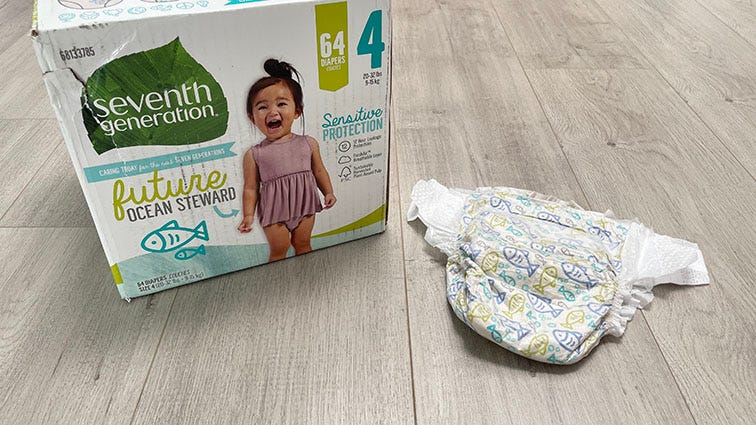

Alex Nishimoto/CNET
Seventh Generation has established itself as an eco-conscious brand, touting the use of plant-based ingredients in its products and an emphasis on recycling. With a disposable diaper, there’s only so much you can do today to make it less harmful for the environment, but Seventh Generation is at least making an effort.
The company says the fluff pulp used in its diapers is harvested sustainably and is Forest Stewardship Council-certified. Seventh Generation diapers are also certified 30% bio-based by the US Department of Agriculture, meaning they’re made with a certain amount of plant-derived materials.
Being made of natural ingredients is great, but how well do they handle a baby’s natural body functions? About as well as the rest, it turns out. We experienced no leaks or blowouts in our testing and found the fit to be just fine. The waistband is stretchy and the leg holes are snug around my daughter’s plump thighs. One downside is there is no wetness indicator strip, so you’ll just have to go by feel unless you change your baby regularly anyway. Just like others on this list, overnight use pushed these diapers to their limit. Again, there were no leaks, but her skin was always damp and sometimes cold.
At 32-56 cents per diaper, Seventh Generation will only be worth it if you believe in the company’s green mission. The truth is, you’re still using a disposable diaper at the end of the day, and regardless of where the materials come from, it will still sit in a landfill where it will not break down for hundreds of years. The company is at least transparent about its diapers not being biodegradable.
How I tested
I tested each infant diaper on my daughter for two full days and nights. She goes through six diapers a day on average and poops pretty regularly. As I mentioned above, we’re a Huggies household. But it just so happened my daughter was ready to move up a size at the start of the test, so even though my wife and I had plenty of experience with the Huggies in size 3, the size 4 Huggies were completely new to us and we spent the same amount of time with them as the rest of the diapers on this list.
I evaluated each diaper based on the following criteria:
- Material quality: How soft is it on my baby’s tush? Does it feel as soft on the outside or is it smooth and plasticky?
- Ease of use: How easy is it to get the Velcro flaps opened and fastened to the front of the diaper? How easy is it to tell when my daughter is wet?
- Absorption: How well does the diaper keep my baby dry, especially overnight?
- Fit: How well does it fit? Do the leg holes create a tight enough seal to prevent leakage or blowouts? Is the waistband tight while still being comfortable?
- Cost: How economical would it be to use a given diaper? Is it worth the money?
- Environmental impact: Is any part of it plant-based or sourced sustainably? Is the company doing anything to offset the waste its diapers generate?
What makes a comfortable diaper?
Going into this test, I thought the answer to this question would be clear-cut. But just like diapers themselves, this question has many layers. For example, it’s important to first understand what makes a baby uncomfortable when wearing a diaper. Once again, here’s Carlos Richer of Diaper Testing International:
“There’s a bit of a misunderstanding of why babies cry in the middle of the night when they’re not even hungry. Babies cry not because the diaper is leaking — they don’t care about that. They cry because they are cold. The urine is warm as soon as you pee on the diaper, but 15-30 minutes after it becomes cold because it gets to room temperature, let’s say that’s 70 degrees. What happens when the liquid inside the diaper goes to 70 degrees and you squeeze the diaper with a little bit of pressure and it wets your skin? So what’s happening here is as soon as you have a diaper that’s wet into the surface it will transfer that dampness to the skin of the baby … When you allow the urine to get to room temperature you cannot go to sleep. It’s just impossible.”
Richer goes on to explain that this phenomenon of liquid making contact with the skin is evaluated by something called the rewet test. In this test, a certain amount of synthetic urine (not water, as that’s not a good analog for urine due to the saline content in your pee) is poured into a diaper. Afterwards, pressure is applied to simulate the weight of a baby and a filter paper is placed on top to observe how wet or dry the surface is. This is different from the retention test, which measures how well the absorbent core holds urine when placed in a centrifuge. The retention test gives you an idea of the overall capacity of the diaper and how long it can go between changes. The rewet test, on the other hand, gives you an idea of how dry the baby will feel and how much urine is making contact with their skin.
“When you are talking about comfort, the most important parameter you have is rewet,” Richer says. “And rewet has a very nasty correlation. The higher it is the more diaper rash you are going to have, because after prolonged time exposed to wetness you are breaking the skin, making it prone to rash and infection.”
So how can you prevent this? The sad truth is it’s pretty difficult in the economy tier. Diapers in this category are engineered according to a template or recipe of ingredients, which is decided based on the price of the diaper. This gives manufacturers a certain amount of materials to work with, including super absorbent polymer and ADL, or acquisition distribution layer, a special type of nonwoven material that quickly channels urine into the core while also providing a wicking effect that helps keep moisture away from the top sheet.
In the end, though, the diaper is built to a price and there’s only so much you can do. The best way to ensure comfort and fight diaper rash is to change diapers regularly.
What makes a diaper eco-friendly?
The diaper industry is taking note of shifting attitudes when it comes to reducing waste, lowering our carbon footprint and responsibly sourcing renewable materials. Many companies claim to be environmentally friendly, but there’s a lot of work still to be done. Currently, no disposable diaper is truly compostable or recyclable. Dyper has a program where you can pay to send your fecal footballs to a commercial composting facility. However, this requires adding certain elements to the compost mix to negate the production of methane gas and dilute the salinity of the diaper cores.
Richer believes that someday soon we’ll see far fewer diapers sent to landfills. Instead, we might see a mix of industrial aerobic composting and industrial recycling, with facilities that can sterilize, shred and sort diaper components to be reused. If practical and energy-efficient, that sounds like a great alternative to just sending thousands of tons of diapers to the dump.
The information contained in this article is for educational and informational purposes only and is not intended as health or medical advice. Always consult a physician or other qualified health provider regarding any questions you may have about a medical condition or health objectives.

